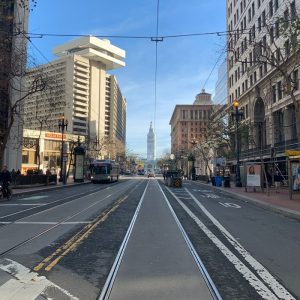Link About It: This Week’s Picks
Mesmerizing footage of the sun, health benefits from magic mushrooms, the history of food photography and more

29 Nigerian English Phrases Added to the Oxford English Dictionary
 The latest update to the Oxford English Dictionary includes 29 words, phrases and colloquialisms from Nigerian English—most of which have been used for decades, and have been adopted by English-speakers elsewhere. Some words already exist in English, but have a different meaning; such as “gist,” which in Nigerian English “is a noun which means ‘rumor’ but also a verb, which means ‘to gossip.'” Other words are entirely new, like “tokunbo” which is “a Yoruba name often given to a child born in a foreign land [and] became a popular tag used for secondhand cars imported into the country as new car sales crashed in the 1980s’ economic downturn. It’s now used for all manner of imported secondhand items.” These useful additions recognize Nigerian English’s contribution beyond its homeland and reflect the ever-evolving nature of language. Read more at Quartz.
The latest update to the Oxford English Dictionary includes 29 words, phrases and colloquialisms from Nigerian English—most of which have been used for decades, and have been adopted by English-speakers elsewhere. Some words already exist in English, but have a different meaning; such as “gist,” which in Nigerian English “is a noun which means ‘rumor’ but also a verb, which means ‘to gossip.'” Other words are entirely new, like “tokunbo” which is “a Yoruba name often given to a child born in a foreign land [and] became a popular tag used for secondhand cars imported into the country as new car sales crashed in the 1980s’ economic downturn. It’s now used for all manner of imported secondhand items.” These useful additions recognize Nigerian English’s contribution beyond its homeland and reflect the ever-evolving nature of language. Read more at Quartz.
Trace Architecture’s Stunning Bookstore in a Tiny, Rural Chinese Town
 Located on the outskirts of Xiadi, a tiny town in China’s Fujian Province, a stunning new Trace Architecture-designed bookstore occupies a once-abandoned residence. A model for sustainable structural reuse, the pre-existing building’s two foundational concrete walls act as bookshelves—and a stark contrast to natural wood accents and skylight. Outside, guests are greeted by a glass-walled cafe at ground level (with panoramic views of the surrounding terrain) and an awning-covered outdoor space on top of the bookstore. Officially a branch of the Librairie Avant-Garde, the shop is inspirational and a visit might be as enthralling as reading a book bought there. See more at designboom.
Located on the outskirts of Xiadi, a tiny town in China’s Fujian Province, a stunning new Trace Architecture-designed bookstore occupies a once-abandoned residence. A model for sustainable structural reuse, the pre-existing building’s two foundational concrete walls act as bookshelves—and a stark contrast to natural wood accents and skylight. Outside, guests are greeted by a glass-walled cafe at ground level (with panoramic views of the surrounding terrain) and an awning-covered outdoor space on top of the bookstore. Officially a branch of the Librairie Avant-Garde, the shop is inspirational and a visit might be as enthralling as reading a book bought there. See more at designboom.
Portland, Maine’s Plan to Become a Technology Town
 Private equity firm co-founder David Roux’s donation of $100 million will help to translate Portland, Maine’s commitment to technology—and its ability to accelerate economic growth—into research and graduate programs under the Roux Institute banner. Northeastern University will manage the programs, and attendees can earn masters and doctorates in AI and machine learning. While Portland isn’t struggling economically (its unemployment rate is 2.2%), city officials and economists fear that its sputtering growth rate is reason for future concern. To balance out the concentration of technological talent around the country, Roux wants “to bring cutting-edge technology capabilities here to Maine and northern New England.” Read more at The New York Times.
Private equity firm co-founder David Roux’s donation of $100 million will help to translate Portland, Maine’s commitment to technology—and its ability to accelerate economic growth—into research and graduate programs under the Roux Institute banner. Northeastern University will manage the programs, and attendees can earn masters and doctorates in AI and machine learning. While Portland isn’t struggling economically (its unemployment rate is 2.2%), city officials and economists fear that its sputtering growth rate is reason for future concern. To balance out the concentration of technological talent around the country, Roux wants “to bring cutting-edge technology capabilities here to Maine and northern New England.” Read more at The New York Times.
One Dose of Psilocybin May Offer Longterm Relief From Anxiety and Depression
 Some five years after initial reports from their study, scientists at NYU Langone Health have found that one dose of psilocybin—which is found in magic mushrooms—can provide cancer patients with long-lasting relief from anxiety and depression. In 2016, 29 patients took part in the study (which also involved nine psychotherapy sessions), with many reporting after six months to have a more positive and less fearful attitude. Following up with 15 of those patients “3.2 and 4.5 years later” has offered more optimistic results: over 70% have credited “positive life changes to the therapy experience, rating it among ‘the most personally meaningful and spiritually significant experiences of their lives.'” Read more at CNN.
Some five years after initial reports from their study, scientists at NYU Langone Health have found that one dose of psilocybin—which is found in magic mushrooms—can provide cancer patients with long-lasting relief from anxiety and depression. In 2016, 29 patients took part in the study (which also involved nine psychotherapy sessions), with many reporting after six months to have a more positive and less fearful attitude. Following up with 15 of those patients “3.2 and 4.5 years later” has offered more optimistic results: over 70% have credited “positive life changes to the therapy experience, rating it among ‘the most personally meaningful and spiritually significant experiences of their lives.'” Read more at CNN.
High-Definition Video of the Sun’s Strange Surface
 Captured using Hawaii’s Daniel K Inouye Solar Telescope (the world’s largest), this high-definition video of the sun’s surface is the closest observation earthlings have ever seen. Comprised of cell-like eruptions marked by bright centers and darker outlines, this particular swatch of the sun comprises 200 million square kilometers, and each individual “cell” is equal to the size of France. The first of many videos to be taken on the newly built set-up, this footage could crack the many mysteries surrounding our sun—namely why its surface is significantly hotter than its core. See the video and learn more at New Scientist.
Captured using Hawaii’s Daniel K Inouye Solar Telescope (the world’s largest), this high-definition video of the sun’s surface is the closest observation earthlings have ever seen. Comprised of cell-like eruptions marked by bright centers and darker outlines, this particular swatch of the sun comprises 200 million square kilometers, and each individual “cell” is equal to the size of France. The first of many videos to be taken on the newly built set-up, this footage could crack the many mysteries surrounding our sun—namely why its surface is significantly hotter than its core. See the video and learn more at New Scientist.
Cars Banned From San Francisco’s Busiest Street
 In an effort to ease congestion, improve conditions for cyclists, and make way for publicly funded restorations of sidewalks, transit lines and streets, San Francisco officially banned the presence of cars (except some official vehicles) on the city’s busiest thoroughfare: Market Street. Following similar legislation passed in cities including Paris, Madrid and NYC, San Francisco formulated a $600 million plan to revitalize its current systems and set a path for future solutions. For most cities, traffic patterns influence the rate at which projects get proposed, allotted, funded and executed—and which social and environmental issues (like access to public transit and carbon emissions) are addressed. With cars pushed aside, pedestrians and cyclists benefit from safer streets and are more inclined to walk and ride, while public acknowledgement of cars as a privilege and not a right opens a dialogue surrounding their impact on our environment and society. Read more about the significant change in SF at CityLab.
In an effort to ease congestion, improve conditions for cyclists, and make way for publicly funded restorations of sidewalks, transit lines and streets, San Francisco officially banned the presence of cars (except some official vehicles) on the city’s busiest thoroughfare: Market Street. Following similar legislation passed in cities including Paris, Madrid and NYC, San Francisco formulated a $600 million plan to revitalize its current systems and set a path for future solutions. For most cities, traffic patterns influence the rate at which projects get proposed, allotted, funded and executed—and which social and environmental issues (like access to public transit and carbon emissions) are addressed. With cars pushed aside, pedestrians and cyclists benefit from safer streets and are more inclined to walk and ride, while public acknowledgement of cars as a privilege and not a right opens a dialogue surrounding their impact on our environment and society. Read more about the significant change in SF at CityLab.
160 Years of Food Photography
 While many roll their eyes when people stand on a seat to snap a photo of their meal, it’s worth remembering that food photography has a long history—one that predates Instagram by over 150 years. And, as Susan Bright (author of Feast for the Eyes: The Story of Food in Photography and co-curator of the current exhibition of the same name) says, it’s not about food; it’s about human identity and values. It used to also be about practicality, as in the early stages of photography, food was an easy subject. “It was a really easy way to say, ‘Look, photography is art,'” Bright says. Find out more about the history of food photography—from still life to snaps for social media, cookbook photography and beyond—at Wired.
While many roll their eyes when people stand on a seat to snap a photo of their meal, it’s worth remembering that food photography has a long history—one that predates Instagram by over 150 years. And, as Susan Bright (author of Feast for the Eyes: The Story of Food in Photography and co-curator of the current exhibition of the same name) says, it’s not about food; it’s about human identity and values. It used to also be about practicality, as in the early stages of photography, food was an easy subject. “It was a really easy way to say, ‘Look, photography is art,'” Bright says. Find out more about the history of food photography—from still life to snaps for social media, cookbook photography and beyond—at Wired.
Our Cosmos is a Spacecraft Graveyard
 While it’s common to think of the universe as dark, mysterious and infinite, it’s less often that we consider all the human-made space junk floating around nearby. The cosmos is a graveyard of spacecraft—each with its own story. These defunct vessels “glide silently in Earth’s vicinity” with “their mission to chronicle the wonders of the universe long ended.” The Kepler, for instance, trails our planet since running out of fuel in 2018. This week, NASA will switch off the Spitzer telescope, which has spent 16 years in orbit. Several companies are attempting to recapture some; “they’re doing it as part of an effort to clean up an environment filled with space junk, but similar technology could be used to pull historically significant spacecraft into higher, safer orbits, or even toward one another to create an exhibit.” Read more about the space graveyard at The Atlantic.
While it’s common to think of the universe as dark, mysterious and infinite, it’s less often that we consider all the human-made space junk floating around nearby. The cosmos is a graveyard of spacecraft—each with its own story. These defunct vessels “glide silently in Earth’s vicinity” with “their mission to chronicle the wonders of the universe long ended.” The Kepler, for instance, trails our planet since running out of fuel in 2018. This week, NASA will switch off the Spitzer telescope, which has spent 16 years in orbit. Several companies are attempting to recapture some; “they’re doing it as part of an effort to clean up an environment filled with space junk, but similar technology could be used to pull historically significant spacecraft into higher, safer orbits, or even toward one another to create an exhibit.” Read more about the space graveyard at The Atlantic.
Link About It is our filtered look at the web, shared daily in Link and on social media, and rounded up every Saturday morning.












